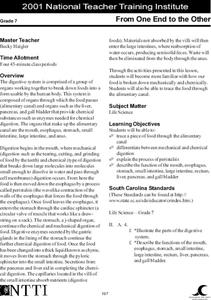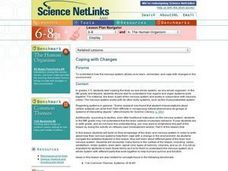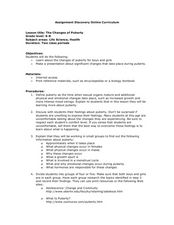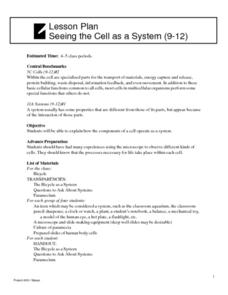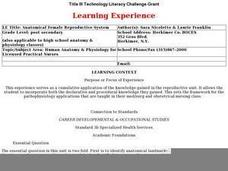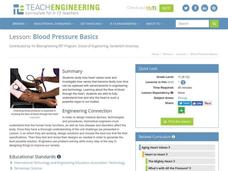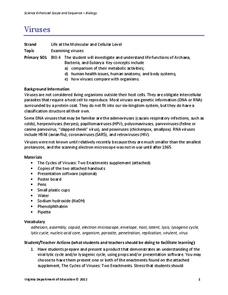Curated OER
Sizing Up the Supersize Croc
Students examine and compare traits of humans and crocodiles. In this crocodile lesson plan students use a ratio to estimate the height of a person and compare that to a crocodile.
Curated OER
TE Lesson: Fighting Back!
Students examine the roles of the immune system in keeping the body healthy. They see how engineers contribute to this process by creating antibiotics, and vaccinations. They discuss how an astronauts' immune system may be suppressed...
Curated OER
From One End to the Other
Seventh graders trace a piece of food through the digestive system. They describe the functions of the mouth, esophagus, stomach, etc.
Curated OER
Coping with Changes
Students build on knowledge of brain and nervous system in order to write about how their nervous systems help them cope with change in environment. Students navigate online sites to explore different parts of brain and nervous system.
Curated OER
A Walk Through the Gut
Students explain what happens to food as it passes through the digestive system. They have a 3x5 index card representing food, which he / she carries to stations around the room. Each station represents one of the organs of the digestive...
Curated OER
Take Deep Breath
Fifth graders become familiar with how the diaphragm expands to draw air into our lungs and contracts to exhale carbon dioxide. They also label the major parts of the respiratory system through the use of interactive Internet research...
Curated OER
Better Body Books, Inc.
Pupils work in groups of 2-3 people to prepare a book about the human body that is suitable for a 3rd, 4th, or 5th grade student.
Curated OER
Your Amazing Body
Students are introduced to the anatomy of the human body. Using the different systems of the body, they look at how different artists made a picture out of paper. Individually, they make a cut out of various internal organs or bones. ...
Curated OER
The Changes of Puberty
Students study about the changes of puberty for boys and girls. In this health instructional activity, students study how the body changes during puberty and make a presentation about a significant change that can take place during...
Curated OER
Seeing the Cell as a System
Students explain how the components of a cell operate as a system. Students examine a bicycle and find out if parts were arranged differently, could the system still be carried out. They look at cells as well and see what function they...
Curated OER
The Inside Story- Cells, Organs, and Systems of the Human Body
Fourth graders study the human body from cell level to the inter-relationships of the systems in this unit. Students practice study skills throughout the unit.
Curated OER
Hardy Heart: Kit Instructions
Students describe human anatomy by reading a children's book. In this heart health lesson plan, students examine illustrations of heart images and several organ related children's stories. Students discuss ways to keep a healthy heart...
Curated OER
Body Battles!
Seventh graders explain the role of white blood cells in fighting infections. In this life science instructional activity, 7th graders create flow charts showing the immune response process. They act out and play a game to simulate...
Curated OER
Anatomical Female Reproductive System
Students dissect internal female reproductive organs and take digital pictures that are exported onto a disc for use with power point technology.
Curated OER
H2O in Us
Students discover through this activity that all organisms are composed of water. They find that 70 percent of their bodies are made up of water that is in thier cells and blood, and not free-flowing throughout their body.
Curated OER
Respiratory and Circulatory Research Project
Students use the Internet and books to research the respiratory and circulatory systems. They also write a report on different diseases and present to the class.
Teach Engineering
Blood Pressure Basics
Under pressure! The second lesson of the series introduces the class to blood pressure and the impact of high blood pressure on the cardiovascular system. It helps learners make the connection between blood pressure and how the heart...
Curated OER
Pregnancy, Day 1: The Developing Baby
Twenty-six pages of good information about pregnancy. Pictures and descriptions describe the moment the sperm and egg unite, and there are worksheets that students can complete. This is a pretty comprehensive lesson for one day. It might...
University of Minnesota
Connect the Neurons!
Create a neuron frenzy as your pupils play the part of the neurons. An engaging lesson plan creates a human chain of neurons that pass cotton balls posing as neurotransmitters. Scholars learn about pre- and post-synapses as they...
Curated OER
The Skeletal System
Students identify bones off a skeleton during quizzes; assemble disarticulated skeletons; bird, frog and rat. They dissect frogs, remove the muscle tissue, and identify of bones.
Curated OER
What's For Lunch? (Digestive System)
Students identify components of the digestive system and explain functions. They create and label a diagram of the digestive system. They watch the video "Passage of Food" and perform a proper dissection of a frog. They create a flow map...
Curated OER
LIFE IN SPACE Human Body: An Un-Earthly Home
Students examine an effect of zero gravity on the human body using a baby food jar, balloons and a jar with a large mouth.
Virginia Department of Education
Viruses
Germs, parasites, and viruses, oh my! Facilitate a lesson on viruses as individuals explore functions of Archaea, Bacteria, and Eukarya. They learn how viruses compare with other organisms in nature and how they contribute to health...
Curated OER
I Need Air
Middle schoolers examine and research the organs of the respiratory system. They participate in a vocabulary card matching game, create a graphic organizer, and participate in an experiment titled, Floating on Air.


